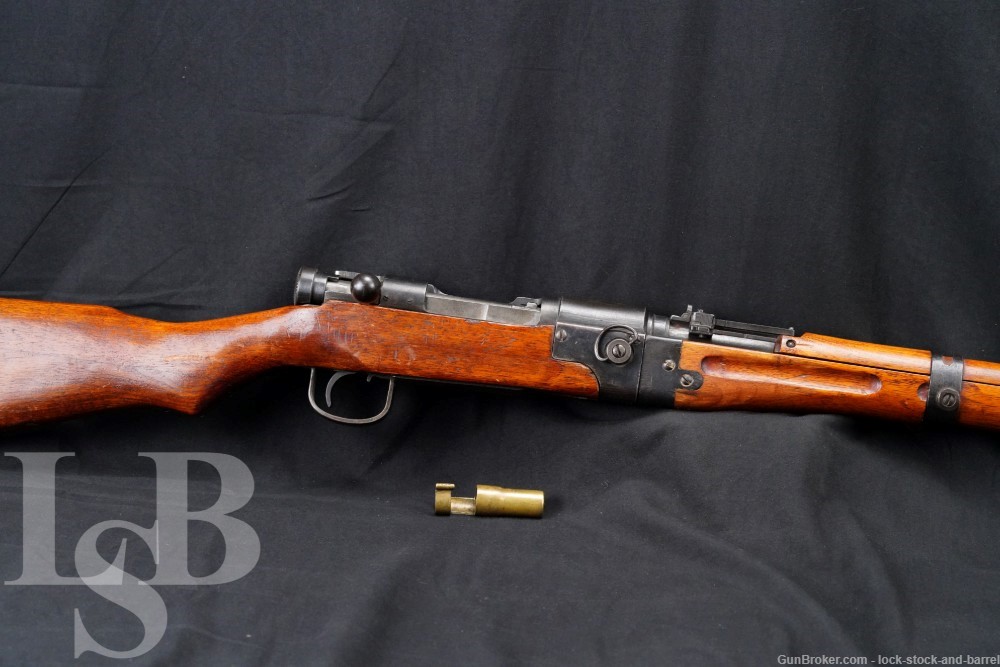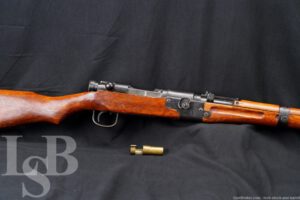
WWII Arisaka Type 2 Paratrooper Takedown 7.7 Japanese Bolt Rifle C&R
SOLD FOR: $2925
LSB#: 230319EH019
Make: Nagoya Arsenal, Japan
Model: Type 2 Arisaka “Paratrooper”. A Takedown Type 99 Arisaka
Serial Number: 11055
Year of Manufacture: 1942 – 1944
Caliber: 7.7x58mm (7.7 Jap)
Action Type: Bolt Action, Internal Magazine
Barrel Length: Approximately 25 1/2 Inches
Sights / Optics: The front sight is an inverted V post set between two protective ears. The rear sight ladder has a fixed aperture when down and a sliding aperture when flipped up. The sides fold out to be used as anti-aircraft sights. There are inverted V notches on each side of the AA sights.
Stock Configuration & Condition: The three piece stock has a pistol grip, finger grooves, nose cap with bayonet lug, hole for the included cleaning rod, barrel band with sling loop, sling loop on the left of the butt with a finger groove above it, drain hole, and metal buttplate. There is a metal joining mechanism below the front of the receiver and the barrel shank. It wraps around the stock and has a “D” ring takedown knob on the right side. The takedown screw is captured so it won’t be lost in the field. The buttplate and stock hardware shows scrapes and discoloration from oxidation. The wood shows numerous scrapes, scratches and compression marks. Some have damaged or small portions of the surface wood. The front half of the stock is lighter in color than the rear half. The LOP measures 12 1/2 inches from the front of the trigger to the back of the buttplate. The stock rates in about Very Good overall condition.
Type of Finish: Blue
Finish Originality: Original to Rebuild
The metal has been treated with cold blue.
Bore Condition: The lands are bright, the grooves are semi bright and the polygonal rifling is well deep. There is light erosion at the muzzle.
In this writer’s opinion, this bore rates 8 out of 10.
Many military and C&R-eligible weapons have bores that will show erosion. This is not only due to age but to the fact that corrosive primers were commonly used in ammunition worldwide. For example, the U.S. used corrosive ammunition throughout WWII. The U.S. military did not begin to phase out corrosive-primed ammunition until the 1950s.
Overall Condition: This rifle retains about 80% of its current metal finish. The metal has been treated with cold blue. The metal shows scrapes, scratches and varying degrees of thinning. The thinned portions of the finish show discoloration from oxidation. The screw heads show heavy use. Most of the markings are well defined. Overall, this rifle rates in about Very Good Plus condition.
Mechanics: The action functions correctly. We have not fired this rifle. As with all used firearms, a thorough cleaning may be necessary to meet your maintenance requirements.
The rifle can be taken down and put together properly.
Box, Paperwork & Accessories: The rifle comes with a Japanese Arisaka brass muzzle cover. It is still under tension from the internal spring.
Our Assessment: The Type 2 Paratrooper rifle is basically a take-down version of the Type 99 Arisaka rifle. The Japanese experimented with several versions of paratrooper rifles, including ones with folding stocks and an interrupted thread-style take-down before settling on this one, which has a screw-in wedge that holds the two halves together. The Type 2 is the only paratroop rifle that was produced in any real quantity with only about 21,200 known to have been produced. The model designation comes from the year based on the Japanese system that counted from the date of the founding of the Japanese Empire in 660 B.C. By this system, the Western year 1942 when the gun was adopted was 2602, with the “2” becoming the model designation.
This Japanese Type II Paratrooper was made during WWII at the Nagoya Arsenal. The rifle looks pretty good for its age. It has deep markings on the metal that include its chrysanthemum. It also has anti aircraft sights and a strong bore. At some point the rifle was rebuilt so the numbers on the bolt and other parts do not match the serial number. The assembly number on the left rear of the joining mechanism has been restamped.
…Now go shoot something!

